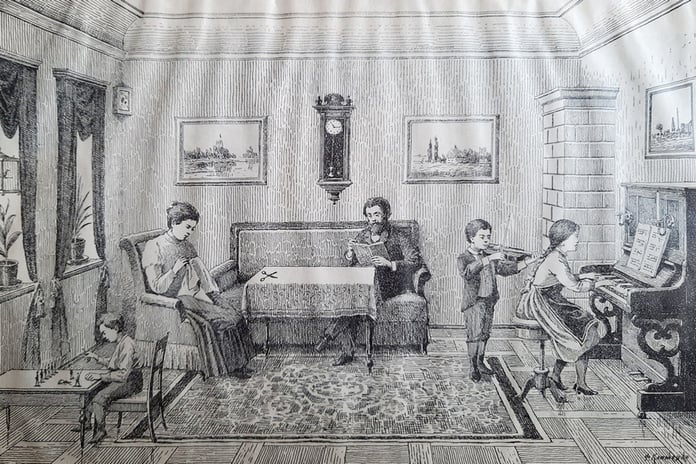merchant idea
Historians believe that the idea of a massive opening of schools for the population of Turkestan belonged to the Tashkent merchant and philanthropist Seyid Azimbay Makhammedbaev. He himself was fluent in Russian and understood that knowing the Russian language would help the region develop.
As the doctor of historical sciences Olga Sumarokova pointed out in her book “The Russian Language in Turkestan: Milestones of the Past”, the merchant shared this idea at one of the official receptions with the Governor General of Turkestan Konstantin Kaufman. The merchant’s latest offer pleased him. But how do you bring the idea to life? The answer to this question was found by Minister of Public Education Dmitry Tolstoy. He told Konstantin von Kaufmann about the system of Russian educator Nikolai Ilminsky.
- During the conversation between the Minister and the Governor General, it turned out that the developed methodology is successfully used in schools for Tatar children, – explained Olga Sumarokova. – Ilminsky believed that the education of the local population should begin not in Russian, but in their native language. The educator has drawn up a program for a four-year course. During the first two years, the training took place in the mother tongue according to manuals drawn up from graphics. The Russian language was introduced gradually – in the form of conversation lessons.
Ilminsky system
On the recommendation of Dmitry Tolstoy, Konstantin von Kaufman turned to Nikolai Ilminsky, hoping to use the latter’s experience in organizing school affairs in Turkestan. In April 1869, the Governor General seconded his official for special assignments to the educator, who at that time lived and worked in Kazan. Through him, Nikolai Ilminsky handed over to the Governor General the compiled book – “Russian Literacy Tutorial for Kyrgyz”. The latter has already been tested in schools in the province of Orenburg, where many Kazakhs lived. In addition to the book, the educator attached a note in which he proposed his plan for the development of schooling in Central Asia. Emphasis was placed on the opening of educational institutions in Turkestan, called “Christian-educational”.
In May 1869, Konstantin von Kaufmann, on his way from St. Petersburg to Tashkent, stopped in Kazan and met Nikolai Ilminsky. During the conversation, it turned out that the scout’s method was unacceptable for Central Asia, since the religious component that he put at the base of his system was not suitable for the region. As a result, the development of Russian-language education in Turkestan was forgotten for some time.
Gramenitsky method
The idea of the massive opening of schools of Russian origin was returned during the years of administration of the territory of Turkestan by Governor General Nikolai Rosenbach. A colossal change occurred at the beginning of the 20th century with the appointment of a talented teacher, Sergei Gramenitsky, as an inspector of public schools in the Turkestan region. He offered to introduce a new methodology into local educational institutions, which he himself developed and strengthened with textbooks compiled by him and “Reading Books” – for Russian-language students.
Sergei Gramenitsky’s books have been approved by the Ministry of Public Education of Russia and admitted to teachers’ libraries. And one of them – “The Third Book to Read”, containing the works of Russian classics, as well as historical and geographical information about Russia – was also sent to people’s reading rooms.
– Gramenitsky’s first two books became one of the first conductors of Pushkin’s poetry in the Turkestan region, – says Olga Sumarokova. – The textbooks included “The Tale of the Fisherman and the Fish”, the introduction to the “Bronze Horseman”, the poems “Horse”, “Winter Road”, “Winter Evening”, “Anchar” and others. Based on the latest achievements of Russian and world pedagogy, Sergei Gramenitsky tried to make textbooks simple, but deep in content, as well as in logical structure. For this, in 1900, at the Universal Book Fair in Paris, he received a silver medal.
By the way, a little later it was on the basis of Gramenitsky’s textbooks that the first textbooks and readers in the languages of the peoples of Central Asia began to be compiled.
However,
The teaching aids compiled by the famous Russian philologist Karl Schelzel enjoyed great popularity in the schools of Turkestan. In particular – “The Russian alphabet. A textbook applied to the teaching of the Russian language in foreign schools” and “The first step in learning the Russian language. A visual aid for students of foreign schools.”
“The reading material in the alphabet was distinguished by its simplicity and relevance, it did not contain words and expressions that are difficult to explain,” the contemporaries noted. “At the same time, the work had a number of drawbacks: the extreme complexity of the notebook drawings, the inconsistent introduction of material devoted to the rules for using the letter “yat” , as well as the oversaturation of the alphabet with images of objects that do not surround students in everyday life.
Read the Latest Science and Technology News Today on The Eastern Herald.


